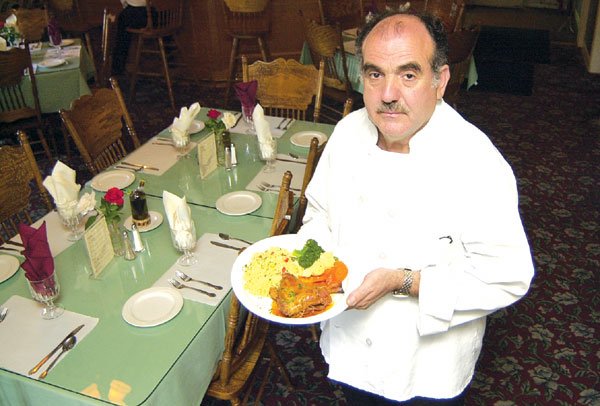Humble flavors
– olive oil, oregano, dill, lemon and garlic – form the backbone
of Greek cuisine, but the simple flavors and uncomplicated style of
these dishes breathe the air of comfort into a meal. Often
underestimated, Greek cuisine is frequently dismissed as too
pedestrian for a gourmand, but in reality i
t’s a quintessential example of fusion at its finest.
Humble flavors – olive oil, oregano, dill, lemon and garlic – form the backbone of Greek cuisine, but the simple flavors and uncomplicated style of these dishes breathe the air of comfort into a meal. Often underestimated, Greek cuisine is frequently dismissed as too pedestrian for a gourmand, but in reality it’s a quintessential example of fusion at its finest.
The Greek mainland is rocky and mountainous, with relatively arid soil, but by virtue of its position on one of the calmest seas in the world, its early residents were able to take to the sea in their quest for goods and knowledge, according to Encyclopedia.com.
Though they possessed no centralized government, the city states of Greece began to expand their world. In the eighth, seventh and sixth centuries B.C., their ships sailed to distant lands, establishing colonies from the Black Sea to Mediterranean France, North Africa and Spain, bringing back with them not only new ideas, but new goods and culinary techniques, the site says.
All of these were adopted to supplement the traditional diet of the ancients, one that was high in olives, olive oil, cheese, bread and vegetables, according to Englishman Andy Harris, who drew upon his childhood summers on the island of Skiathos to create a contemporary collection of Greek recipes titled “Modern Greek.”
These basics were combined with the abundance of seafood surrounding the Greek peninsula and the Ionian islands to its south, and flavored with the rich contributions of other societies.
“Greek food has always been considered the poor relative of other European cuisines,” wrote Harris, and many people believe it to be a mere copy of Turkish traditions based on nearly 400 years of Ottoman rule, according to Sofia Souli, the Athens-based author of “The Greek Cookery Book.”
“When the nomadic Turks arrived to settle along the coasts of Asia Minor, all they can have brought with them is the roughly cured meat on which they lived,” wrote Souli, who noted that Greek households had been centered around their kitchens since ancient times. “An existence on horseback does not favor the growth of delicate cooking, and organized households centered around their kitchens, with utensils and a proper oven, presuppose a settled way of life.”
At Easter time this “settled way of life” is most evidently on display. A celebration of rebirth, the feast arrives after 40 days of Lenten fasts and a long week of celebration. Throughout Holy Week, churches fill each evening as Greeks, 98 percent of whom are Orthodox Christians according to the Central Intelligence Agency’s World Factbook, follow the pageantry that accompanies the week of the Passion of Our Lord, according to Souli.
Traditionally, eggs dyed a blood red are knocked together as revelers repeat the traditional phrase “Christos Anesti,” meaning “Christ is risen,” just after they return from midnight services on Saturday night.
Sunday is set aside as a day of feasting, with whole villages gathering to roast lambs on spits, to drink retsina wines and to enjoy hours of dancing, according to Souli.
These same celebrations take place across the United States and, indeed, the world, as emigrants celebrate their homeland.
But the festivities of pascha, as Easter is known in Greek, have changed significantly in the country itself. Rapid industrialization and increasingly Westernized culture have brought younger generations a diet of burgers, pizza and restaurant fare, and the cooking for pascha is less likely to be done in the family fire pit than it is in a local restaurant, where table space is booked months in advance for large families to gather and celebrate the day.
Greek recipes
Roast Leg of Lamb
by Toula Patsalis, owner of Kitchen Glamor cookware shops, Detroit, Mich.
Though most Greeks cook a whole lamb for Easter, leg of lamb is more common in American grocery stores, so this recipe has been adapted to such constraints.
1 leg of lamb (8 to 10 pounds, bone in)
3 cloves garlic, cut in quarters
1 cup marinade
Marinade:
1/2 cup light olive oil or vegetable oil
2 cloves crushed garlic
1 c. fresh lemon juice
2 Tbs. dried oregano (rubbed between the palms of the hands to release oils)
1 tsp. dried rosemary
1 tsp. salt
1/2 tsp. freshly ground pepper
Step 1: Preheat oven to 425 degrees. Trim excess fat off lamb. Make six incisions on top of lamb and insert garlic slivers. Repeat on bottom side.
Step 2: Place on rack in roasting pan. If using meat thermometer, insert in thickest portion of leg. Cook 20 minutes and reduce heat to 350.
Step 3: Brush with marinade and continue cooking to desired doneness. Baste liberally every 20 minutes. When done, remove from oven and allow lamb to rest 10 minutes before carving.
Note: Roasting times with internal temperatures: 10 to 12 minutes per pound for rare (145 degrees on meat thermometer), 15 minutes per pound for medium (155 degrees) and 20 minutes per pound for well-done (165 degrees.)
Aunt Mary’s Dolmathes
Courtesy of Konnie Zaharopoulos
These meat-filled grape leaves are topped with a tangy lemon sauce and served hot, but if you prefer a cold appetizer, substitute cooked rice for the meat and serve them chilled.
1 onion, minced
1 tsp. olive oil
1 8-oz. can tomato sauce
1/2 cup water
3 lbs. ground beef
1/2 cup raw rice
1/2 bunch minced parsley
2 sprigs mint, chopped
fresh dill, chopped
grape leaves
Step 1: In a sauce pan, sauté onion in olive oil. Add tomato sauce and fry until thick. Remove from heat and add water.
Step 2: In a large mixing bowl, blend onion-tomato mixture with ground beef, rice, parsley, mint and dill. Roll spoonfuls of spiced meat into grape leaves (vein side of leaf in). Place in pot and cover with a small plate so they do not unravel while cooking, then fill pot with water to within an inch of the top of the dolmathes. Cook with cover fro 45 minutes.
Step 3: When dolmathes are done, remove from pot, but keep the resulting broth. Beat the raw egg with the juice of one lemon and pour mixture slowly into broth while stirring to cook the egg. For a thicker sauce, melt two tablespoons of butter in a sauce pan and stir in two tablespoons of flour. Add to broth and cook until thickened, then remove from heat and add the egg and lemon. Stir and pour over the dolmathes.
Pasticho
Courtesy of Christina Zaharopoulos
Pasticho, an almost cake-like version of macaroni and cheese, is a festival staple and an even tastier treat when eaten as a cold leftover.
1 lb. macaroni
1 cube butter
1 cube margarine
1/4 cup flour
1 qt. milk
1 can grated parmesan cheese
4 eggs
cinnamon
Step 1: Melt butter in a sauce pan and add flour. Cook until brownish. Beat eggs, then add milk and eggs to the pan, stirring slowly until it boils and becomes thick.
Step 2: Drain cooked macaroni and sprinkle with some of the cheese. Mix, then add the remaining cheese to the sauce.
Step 3: Place macaroni in a buttered cake pan, cover in sauce and sprinkle with cinnamon. Bake at 400 degrees for 30 minutes or until done. To test for doneness, insert a knife into the pasticho. When it comes out clean, the pasticho is done.















